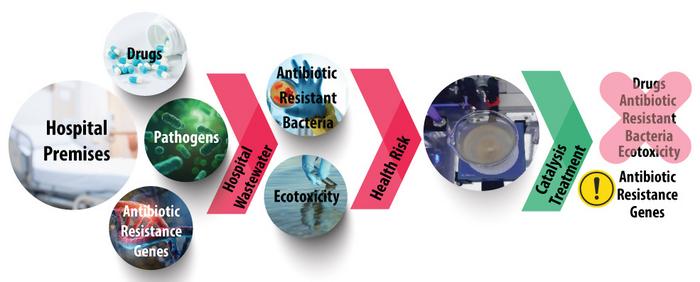In a paper published in the Journal of Chemical Technology and Biotechnology, a multidisciplinary team including biologists, chemists, chemical engineers, and environmental scientists have investigated the characteristics of wastewater samples from one of the largest hospitals in Crete, and demonstrated the effectiveness of treating the water using photocatalytic treatment.

Credit: Danae Venieri, Technical University of Crete
In a paper published in the Journal of Chemical Technology and Biotechnology, a multidisciplinary team including biologists, chemists, chemical engineers, and environmental scientists have investigated the characteristics of wastewater samples from one of the largest hospitals in Crete, and demonstrated the effectiveness of treating the water using photocatalytic treatment.
Conventional sludge wastewater treatment programmes are ill-equipped to effectively process hospital wastewater. Considered highly toxic to ecosystems and humans, the water can contain a cocktail of contaminants including pathogenic microorganisms, hormones, and other pharmaceutically active compounds. Perhaps most significantly, high concentrations of antibiotics in the effluent can favour the development of antibiotic resistant bacteria (ARB).
Danae Venieri, Professor of the Environmental Microbiology Laboratory at the Technical University of Crete, and corresponding author of the study, explained the major challenges presented by the unique contaminants in hospital wastewater.
Speaking to SCI, she said: ‘The exact composition varies depending on the specific streams that are combined in the hospital treatment plant. Although pharmaceutically active compounds that exist in such effluents may escape intact and accumulate in the water cycle, the single most important threat possibly comes from the transfer of antibiotic resistance genes (ARGs). Such genes have received far less attention with respect to their detection in aqueous streams and this is where our work comes to fill the gap.’
The transfer of these ARGs between bacteria is the mechanism that drives the evolution of antibiotic resistance, making their presence in hospital wastewater a major concern for public health. Venieri explained, ‘ARGs have only recently become the focus of research activity simply because researchers ignored the implications of their existence, if not their existence as such. By analogy, nobody cared about the presence of chemical micro-contaminants (e.g. pesticides, pharmaceuticals, endocrine disruptors, microplastics) in various water matrices some 20-30 years ago simply because nobody could detect them’.
The researchers found that there was high toxicity and significant levels of ARBs and ARGs in the hospital wastewater samples they analysed, particularly in the wastewater derived from the Pathology and Oncology unit. By utilising a treatment method known as photocatalysis, which employs UV-A light to break down the contaminants in the water, the study reported a decrease in pharmaceutically active compounds and bacteria of over 80%.
Significantly however, the concentration of ARGs remained high, following the treatment. Despite this, the authors conclude that coupling photocatalysis onto the end of conventional wastewater treatment programmes is a step in the right direction.
Prof. Venieri explained that there were three requirements which would allow photocatalysis to become a sustainable solution for hospital wastewater treatment:
1. The concentration of target contaminants and pollutants in hospital wastewater is below a threshold. This was found to be the case in the current work.
2. Natural sunlight can be employed for large scale applications, a cheaper alternative to artificial UV light.
3. New photocatalytic materials that are inexpensive, sensitive to visible light and stable are developed.
She also noted, ‘Equally important is to convince policy-makers and stakeholders at national and international levels that wastewater treatment goes well beyond the traditional activated sludge process. Raising public awareness and educating the younger generations are perhaps more challenging than solving technical issues.’
Prof. Venieri and the team are continuing to develop their trans-disciplinary research at the interface of science and engineering:
‘The next step is to move our research forward, developing pilot-scale units and applications for the on-site treatment of hospital wastewater. A pilot-scale unit has already been installed in the premises of a hospital in Crete and the results so far are quite promising regarding the elimination of pathogens and ARGs from hospital wastewater’, noted Prof. Venieri.
Journal
Journal of Chemical Technology and Biotechnology
DOI
10.1002/jctb.7329




